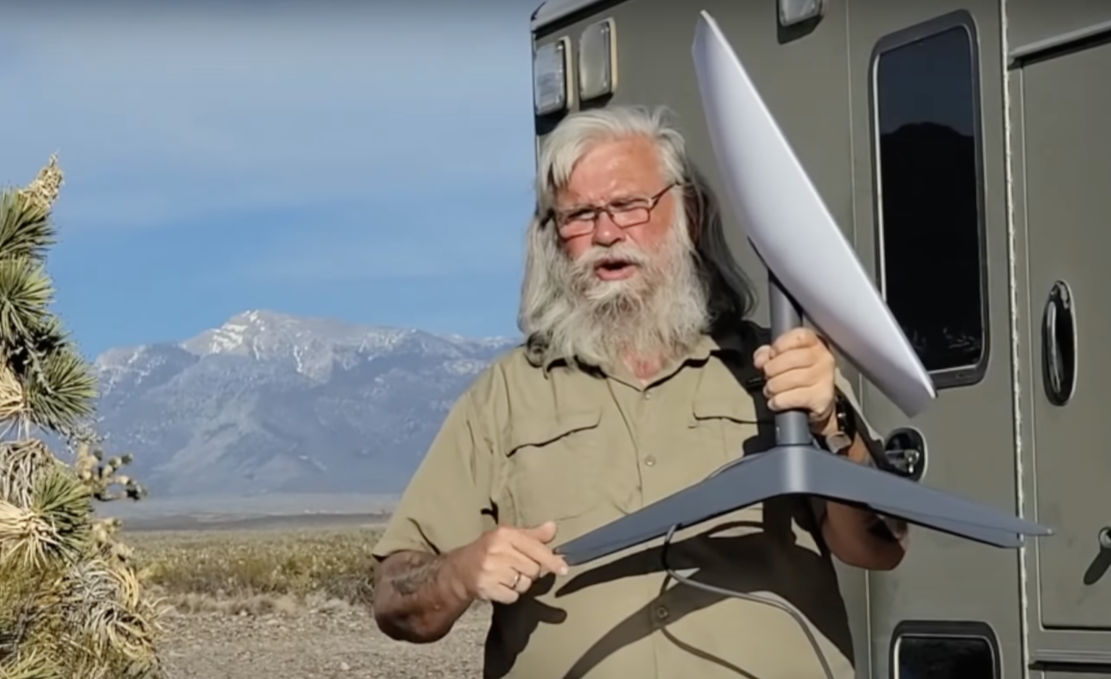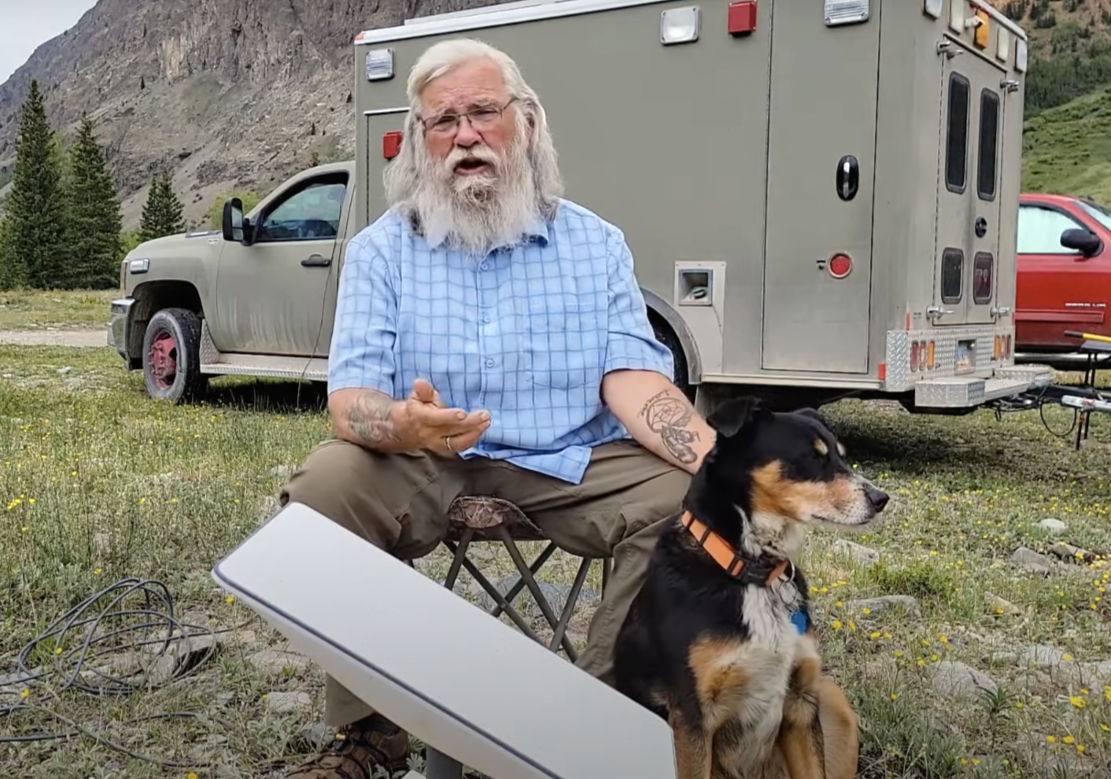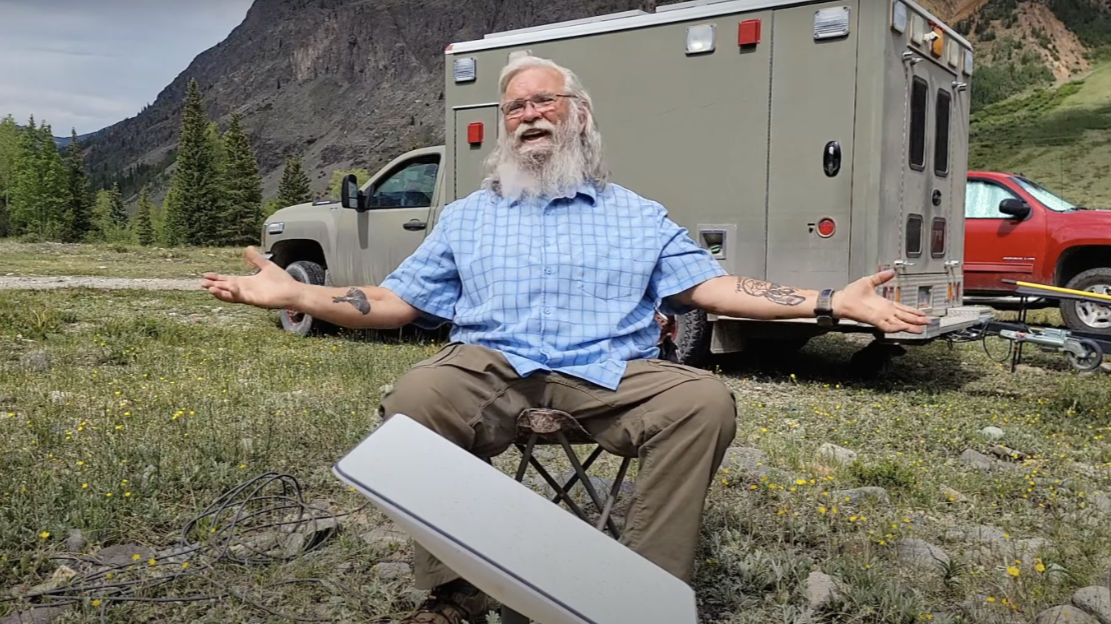
I’VE BEEN USING STARLINK for a while now, so let me give you my impressions on ease of use, signal availability, and speed. Is it a good answer for nomads who need to stay connected to reliable Internet wherever they go? I’m going to look at five things to make my assessment.
1. The Fuss Factor
I’m the type who will stop using a product if it requires a lot of time and attention and calls to customer support, if it’s tricky to set up and needs repeated fiddling to keep it working. I’m very happy to report Starlink hasn’t required any of that.
Setup is simple. There’s the antenna, a base, a router, the cables for the antenna and router, and a power brick. You slip the antenna onto the base, connect the cables, and plug it in. There’s not even an ON button. It just comes on and works. Like magic. I love when technology works.

Then the antenna automatically searches for satellites and aims itself. It takes a few minutes then, boom, you have a signal. Then you connect your digital device to the wifi router in the usual way.
Those of us nomads who spend time in windy places will probably want a way to stake the antenna base to the ground. I bolted mine to a piece of plywood that I can drive stakes through. If you want to mount Starlink to your RV or other rig, various companies offer different types of fittings.
You’ll need space in your rig to stow the antenna, base and cable while driving. That could be a limiting factor for nomads in small vehicles.
2. Power Usage
If you’re going to use Starlink off grid, you’ll need enough power to run it. If you need/want to be online most of the day, I suggest at least 100 Watts on top of your current electricity needs. I think 200 Watts would be better. That would be enough to get you through days with little-to-no sunlight to recharge your batteries. However, you can save power by unplugging Starlink whenever you aren’t using it. It boots right back up when you plug it in again.

3. Speed
Old style satellite Internet was very slow compared to ground-based Internet. Starlink is much faster than previous satellite Internet but still a little slower than ground-based speeds. Yet it’s as fast as I could want. I never have to wait.
Of course, the speed comes with some caveats. And extra fees. Starlink was originally intended for use at a single location—your home or business. Traveling with Starlink required some hokey-pokey to change your registered location each time you moved.
But Starlink recently introduced a plan for mobile users. For an extra $25 a month you can roam all you want within the continent where you registered for service. The hitch is you will be prioritized when outside your original location.
“Users can expect high speed, low latency internet in areas marked ‘High Capacity,’ and notably slower speeds during hours of peak usage in areas marked as ‘Low Capacity’ or during events with many collocated users.” —Starlink
I’m paying for the roaming ability—because I roam and because I don’t want to deal with the fuss factor of frequently switching registered locations. And as I said, the speeds have been more than satisfactory. So far. It will be interesting to see what happens in someplace like Quartzsite when a lot of Starlink users “collocate” there for the winter.
4. What About Rain?
If you’ve had satellite TV you know you can lose the signal during heavy storms. But I’ve been through several storms—including hail—with Starlink with no service interruptions yet. That’s great for those of us whose livelihood (or craving for streaming and gaming) depends on a solid net connection.
5. What about trees, narrow canyons and tall buildings?
You know I like to get way out in the boonies, as far from crowds as I can. That’s why I got my 4×4 ambulance, and a side-by-side to go even farther. But while Starlink can connect me where no cellular signal can reach, it has its limits. It needs a clear view of the sky in order to connect with the satellites. That means I have to avoid trees, canyons and tall buildings. That’s a tradeoff I’m willing to make because I need Internet to upload my videos to YouTube and for teleconferencing. As you can see, I’m camped in the mountains. The spot isn’t as far into the boonies as I’d like to be, but it’s still farther than I could be if I depended upon cellular.
If you think your location might have enough unobstructed sky, Starlink has an app to help you see whether you have a large enough opening, or to help you decide between a few openings. Sometimes it’s just a matter of moving the antenna a few feet.

Conclusion
Starlink works great (except in the type of locations mentioned above) but it’s not cheap. The hardware is currently $599, plus tax and shipping. That’s a big chunk of change for most of us. And it’s even pricier if you need to upgrade your electrical system in order to power it.
Monthly service for a static location is currently $115/month or $135/month for the roaming plan. That’s in the ballpark with unlimited data plans from the big cellular providers—but with far more reach.
If you’re a digital nomad who really wants to go where cell signals can’t, then the price of Starlink is a cost of doing business.
I highly recommend Starlink if you can afford it. As I’ve said many times before, having an emergency fund and being able to buy the essentials is most important of all.
Tell me what you think. Where would you put Starlink on the Absolute Necessity-to-Ridiculous Extravagance Scale? Leave your comments below.

I’m considering it. Thank you for reviewing. I was very interested when I first learned of Starlink months ago. I am a digital nomad as I earn my wages consulting online. A reliable connection is critical. I am willing to rearrange my budget to have this. I’m hoping the cost goes down. Maybe I’m dreaming. Ha!
I am on Verizon, cell phone and hot spot, both with 50gb unlimited data. I pay $140 a month. I am not a digital nomad, just an old retired poor man. I’ll save that $599 plus tax and shipping for something else.
I’ve wanted Starlink since before it’s available. Each review quotes a higher price. First I heard was $90 per month, I wonder if he is still paying that?
For now it will stay a “want” and I’ll continue with half expense cell and public Wi-Fi.
the current price is $110/mo plus $25 for portability that allows you to use it at a ‘home’ location with full priority and move it about as you like. There is an RV plan too, identical equipment, for $135/mo that allows you not to have a home base but you potentially have reduced priority after static users, so far this doesn’t seem to be an issue and I doubt it ever will be in remote areas (Quartzsite will be interesting) The advantage of the RV plan is that you can turn it on and off when you want to if you are not using it (on a month by month basis).
I’ve had Starlink for about 8 months now and traveled all over the southwest with it. You appear to have the rectangular dish so I’m wondering what your ‘power brick’ is? Inverter? The power supply for the rectangular dish is in the router unlike the older round dish.
I power the router using a Folkma 300W inverter, that unit has a Watt meter on the LCD and typically shows 35-40W during normal usage, it peaks at about 120W when starting up, I haven’t used the snow melt feature yet to know what that draws, the older round units used about 100W in normal use.
I recently took my unit tent camping, power was from an 206AH SOK marine lithium battery, it worked great even after the Folkma got wet in a Utah monsoon downpour. The rain was heavy enough a couple if times that I was offline for 25-60 minutes. I’ve been surprised by how well it works in the trees, find a small clearing with a reasonable northerly view and it works pretty well, if it seems to be struggling moving it just a few yards can make a big difference. Even though it ‘follows’ the satellites all over the sky it seems to be best at getting a connection to the north.
Like you I like to get way out there but want to be connected and Starlink has been life changing from that point of view.